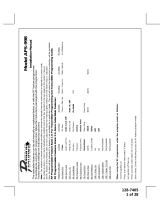
128-9306
11 of 32
11
+ 12 volts to the brake light circuit, connect the Brown w/ Black trace wire to the output side of the brake
switch. This will allow the Remote Start to shut down if an attempt is made to operate the vehicle without
the key while running under the control of the Remote Start. In most vehicles, in order to shift into gear,
the brake pedal must be depressed. The brake input will in turn cause the remote start unit to shut off.
6 DK. Blue w/ Black trace Wire: External Trigger Input
The Dark Blue/Black trace wire allows the remote start unit to be activated from an external source. The
intent of this wire is to allow the unit to be controlled from a "Car Connection" / or "CAR-LINK" paging
system or similar device. When this wire receives a ground pulse, the unit will start the vehicle. Connect
this wire to a ground pulsed output from the controlling circuit.
7 Orange w/ Black trace Wire: (-) Parking Brake Input
This wire is used only when the turbo timer mode, Bank 3, feature # 16 is selected ON. This input insures
that the vehicle parking brake is applied whenever the vehicle is set up for and the turbo timer circuit is used.
This input must switch to ground when the vehicle's parking brake is applied. Connect the Orange/Black wire
to the negative output of the vehicle's parking brake switch.
8 Green w/ Yellow trace Wire: Diesel Wait To Start Input
The green/yellow wire, when connected to the wire that get + 12 volts during the glow plug preheat stage
will delay the starter output until this wire drops the 12 volts. In other words, in a Diesel vehicle with glow
plug preheat circuit, when the ignition is turned on, the vehicle will not crank until the glow plugs are hot
enough to re the atomized fuel oil when injected into the cylinder. By connecting this wire to the glow
plug + 12 volt wire, when the remote start unit activates the ignition one output, the glow plug output also
activates. The remote start sees the green/yellow with positive voltage and waits for this to go inactive(
drop to 0 volts) before activating the starter motor. If this wire is not used or you have difculty accessing
the glow plug preheat circuit, you may elect to utilize the Diesel timed output as specied in Remote Start
feature selection Bank 3 Feature #12.
NOTE: If green/yellow is used, it will override or negate any setting of bank 3 feature #12.
9 Brown Wire: (-) Negative Door Trigger
If the vehicle's door courtesy light switches ground when the door is opened, (Most GMs and Imports),
you must connect this wire to the negative output from one of the vehicle's door pin switches. In most
cases the Brown wire will need to be connected to only one door switch no matter how many doors the
vehicle has as most door lighting circuits are wired in parallel. This wire will be shunted when remote
starting the vehicle and will remain shunted, if active, while running under command of the remote start.
If this wire is active when the system is armed, the siren will emit three chirps. When the zone clears, the
siren will emit 1 chirp to conrm full arming.
NOTE: For vehicles with interior delay lighting see programming under title "Completing The Installation"
10 Green w/ Orange trace Wire: Tachometer Input Signal
This wire will continually monitor the engine's tach rate while the unit is under power of the Remote Start
module. This wire will be routed to the vehicle ECM tach input or through the rewall into the engine
compartment and connect to the negative side of the ignition coil. This Remote Start unit learns the tach
rate of the vehicle and in most cases will operate properly from one coil pack regardless of the number
of cylinders. If the unit has difculty sensing a single coil, this input can connect to an injector wire as
an alternate.
NOTE:For Hybrid mode selection, Bank 3 feature selection 5, this connection is not required, the unit will
start the vehicle and run the allotted time based on feature selection and crank duration.






















